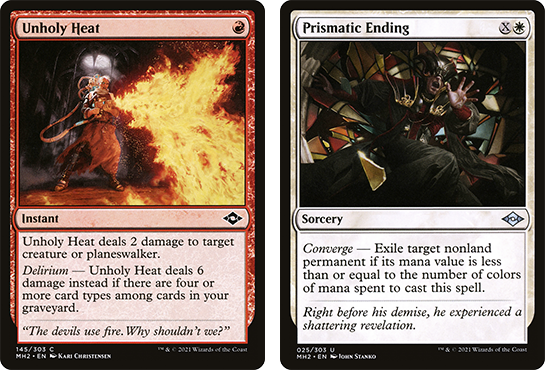Thoughtseize, once a Modern mainstay, seems to be largely missing from the format now. Michael looks at why and where it can still fit in.
Anyone who has played Modern for a significant period of time remembers when Thoughtseize was considered a premium interactive spell. Now, as we move through the middle of 2022, almost 11 years after Modern’s debut, Thoughtseize is rarely seen. Why is a card, once among the most popular and powerful in Modern, merely an afterthought now? The most common causes of this are power level, bannings, or a better version getting printed, however, I don’t think any of these are true for Thoughtseize. What actually happened is that Thoughtseize is a core part of Modern that has been left behind, becoming largely obsolete. In 2022, Modern decks aren’t built in a way that Thoughtseize can capitalize on. Modern isn’t played in a way where Thoughtseize decks can easily pick apart opposing game plans anymore. The biggest contributors to that are an overall increase in card quality, redundancy, and how resources are managed.
Increased Card Quality
It is no secret that the last few years of design in Magic have pushed a lot of older cards into the background of Modern. FIRE design, which started with Throne of Eldraine is about as clear a line I can think of to distinguish old Modern from current Modern. It may seem like an increase in average card quality would favor Thoughtseize, but Thoughtseize is at its best when there is one card in the opponent’s hand that is clearly better than the rest. Average card quality increasing means the delta between the worst and best card in someone’s hand is much smaller. In short, the better that cards are on average, the worse Thoughtseize gets in general.
Gone are the days of Electrolyze, Soul-Scar Mage, and Wild Nacatl. Ragavan, Wrenn and Six, Teferi, Time Raveler, and Omnath, Locus of Creation, and Murktide Regent usher in a much higher card quality across the board. Trading your Thoughtseize for your opponent’s best card was more impactful when the leftovers were cards like Mana Leak, instead of Counterspell or Archmage’s Charm. Thoughtseizing an Omnath often leaves your opponent with something along the lines of a Solitude and a Teferi, which still lets your opponent use their mana in productive ways.
Redundancy
As the Modern card pool grows, decks get more redundant. Combo decks of old, like Scapeshift, were more or less all in on finding Scapeshift to win, which means that a well-timed Thoughtseize could easily spell disaster for those decks. Now Scapeshift, even though it isn’t a top tier deck, has access to Bring to Light, effectively giving them four additional copies of Scapeshift. Hammer Time and Living End are more applicable today given their popularity and strength. Hammer Time often has at least 12 copies of Colossus Hammer, and eight copies of cards that equip Hammer without paying its equip cost. Living End has eight cascade spells, and a pile of cyclers to make sure they find them. Thoughtseize looks awful when all of your opponent’s cards do the same or very similar things.
Looking at a fairer deck like Izzet Murktide the majority of cards fall into one of two categories, Creatures or interaction. It isn’t uncommon to look at a hand of two lands, Dragon’s Rage Channeler, Ragavan, Counterspell, Archmage’s Charm, Unholy Heat, which is a hand that is very resilient to Thoughtseize. Building on this, the companion mechanic adds additional consistency to decks that can support them. This is less common after the banning of Lurrus of the Dream-Den, but Yorion, Sky Nomad makes life difficult for Thoughtseize decks.
Resource Management
Resources come in a variety of shapes and sizes in Magic, but the relevant ones here are raw cards, time, and board position. First things first, generating raw cards is a good way to beat Thoughtseize. This is two fold, first because drawing extra cards makes it more likely to find redundant copies of cards that would be likely targets for Thoughtseize. Second, the decks that Thoughtseize is common in are trying to force both players into a low resource position, which means that generating extra cards means that the Thoughtseize player is stuck one-for-one-ing you, while your cards replace themselves or better. Free spells such as the elemental cycle from Modern Horizons 2, or Force of Negation cost a card to cast for free, which sounds like it creates a favorable situation for Thoughtseize, but the decks where these cards are common generate so many raw cards that the downside is much more manageable.
Because players are casting spells for free, double spell turns are occurring much earlier than they have historically. Thoughtseize struggles here as well because as I mentioned earlier, players have plenty to do with their mana basically all the time now. However, other forms of interaction, namely Counterspells, play well here because if you make the opponent spend mana on a spell that gets answered, it eats some if not all of their turn, where if you Thoughtseize the same card they are free to do something else with their mana. Counterspell much like Thoughtseize will often trade up on mana value, but the difference with Thoughtseize is that you’re trading down on mana actually spent. Modern is currently a tempo positive format, and if you fall behind it is easy for the opponent to end the game rather quickly, which means that the tempo negative nature of Thoughtseize is quite risky.
Board position is quite important in the way that Modern plays right now. Ragavan, Nimble Pilferer can easily run away with the game if left uncontested. You’ll find yourself quickly in a bad spot if your opponent starts with a Ragavan and your turn one is Thoughtseize instead of something that plays to the board, such as Unholy Heat. Cards that generate continuous advantage are more common now than they have been in the past. Wrenn and Six and Dragon’s Rage Channeler are prime examples that will dominate a game if left on board, so removal spells are typically more apt at handling this kind of threat.
Thoughtseize Isn’t Dead Yet
This isn’t meant to be an obituary, but a caution that you should have a real reason to play Thoughtseize instead of just putting it in your black decks. Thoughtseize is still powerful in certain decks or certain spots, but the old Jund style decks are fairly bad homes for Thoughtseize at the moment. Death’s Shadow decks, despite being similar to Jund, are still going to play Thoughtseize because it is an enabler for Death’s Shadow. The advantage of Death’s Shadow compared to other midrangey Thoughtseize decks is that it has the ability to end the game quickly before the opponent can draw out of it.
Yawgmoth is another deck that uses Thoughtseize well, but out of the sideboard. Decks that need to beat specific hate cards, or buy a turn or so to get their own combo set up still utilize Thoughtseize well. Dredge for a long time played sideboard Thoughtseize to try and deal with Rest in Peace before it could hit the battlefield, but in addition to that, Dredge is historically weak against combo decks. I expect Thoughtseize to continue to shine in situations like this, but the black-midrange-pick-the-opponent-apart strategies are in dire straits.
As much as it pains me to admit that one of my favorite cards of all time is on its last legs, I believe it is time for Thoughtseize players to give up the ghost and admit Modern has mostly passed it by. We may return to a point where Thoughtseize is a powerful all-arounder again, but it doesn’t seem like it any time soon while FIRE design is alive and well. As always you can find me on Twitter at @RappaciousOne for questions, comments or feedback. I’ll see everyone back here next week!

Michael Rapp is a Modern specialist who favors Thoughtseize decks. Magic sates his desire for competition and constant improvement.









